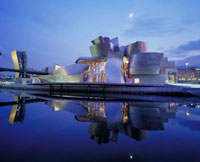 Guggenheim Bilbao, part II
Guggenheim Bilbao, part II
The Basque museum plans to open a second outpostThe Guggenheim Bilbao may get a sister branch
new york.
Not content with having one of the most iconic buildings in the world, northern Spain may now be gaining a rival to its Frank Gehry-designed beacon. The Museo Guggenheim Bilbao is completing feasibility studies for a satellite near the historic town of Guernica, just 40km east of Bilbao. Local and provincial authorities in the Basque Country anticipate that the new museum would extend the so-called “Bilbao effect”—the economic windfall catalysed by Gehry’s celebrated original—to a pristine but underdeveloped coastal region. The Biscay Provincial Council has allocated E1m to fund the environmental and economic analyses, and pledged €100m for construction, about half the estimated cost. But the Basque Country government, whose financial participation is crucial for the project to move forward, is reluctant to undertake the expansion amid the current economic crisis.
The proposed 200-acre site—currently owned by the Spanish bank BBK—is on the west bank of the Urdaibai estuary, a Unesco biosphere reserve a short distance from the Bay of Biscay. Juan Ignacio Vidarte, the director of the Guggenheim Bilbao, notes that land-use restrictions and conservationists have encumbered development. “It’s an area I would not call depressed, but certainly I would call it stagnant,” he told The Art Newspaper, adding that the proposed museum “could bring together culture and nature in a way which could be compatible with the preservation of the environmental quality of the space”.
The concept is to create a modest-sized venue for temporary exhibitions and to commission artists’ interventions in the landscape. Studies estimate that construction would generate around €380m in economic activity, and the annual operation, attracting an estimated 150,000 visitors, could add €85m to the local economy. The impact could be augmented by positioning the new museum as the anchor of a cultural itinerary along the estuary, which features prehistoric cave paintings, Roman ruins and archaeological sites, marble quarries, fishing villages and the town of Guernica, whose devastation by aerial bombing during the Spanish Civil War inspired Picasso’s famous mural of the same name.
Vidarte, who also serves as the Guggenheim Foundation’s chief officer for global strategies, says the proposal is not to create a new independent Guggenheim museum, but a satellite of an existing one. “It would be run and operated by the museum in Bilbao and integrated into our operations,” he explains, estimating additional operating costs as 30% to 40% of the annual €27m budget of the Bilbao flagship or roughly €10m a year. To move into the next stage, which would be the architectural selection process, a funding agreement would have to be reached and the project approved by the boards of both the Guggenheim Foundation in New York and the Guggenheim Bilbao.
“The model we are looking at is similar to the one we followed in Bilbao: public institutions would fund the construction and would be the owners of the site,” Vidarte says. The $100m Gehry landmark was paid for and is jointly owned by the federal, provincial and city governments. “In Urdaibai that combination would have to be agreed,” he says. José Luis Bilbao, the head of the provincial government and president of the Guggenheim Bilbao’s executive committee, asked the recently elected Basque president, socialist Patxi López, to share the cost of the new museum. “This is the time to make important investments,” said Bilbao, noting that the Gehry museum was built “during hard times”.
But in a radio interview last month the Basque culture minister, Blanca Urgell, said that it was not the moment for large investments in infrastructure. She expressed doubts about the viability of a museum 40km from a large city, but politics also seem to have come into play: she questioned the societal impact of the scandal that tainted the Guggenheim Bilbao last year, when the chief financial officer was fired for having embezzled nearly $800,000. Urgell says that the government will not make a formal decision until the results of the environmental and cultural studies are in hand. Vidarte says the reports will be delivered by the end of the year, and he is confident that the Guggenheim in Urdaibai can open as early as 2013 or 2014.
 Guggenheim Bilbao, part II
Guggenheim Bilbao, part II